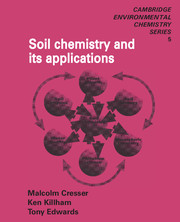8 - The future of soil chemistry
Published online by Cambridge University Press: 05 August 2012
Summary
Conscientious readers of the preceding seven chapters should, at this stage, have a reasonable grasp of the fundamental principles of soil chemistry and should be well aware of its importance in the context of environmental science as a whole. They might well be left asking themselves: ‘Where does the subject go from here? What, if anything, do we still need to do or to find out?’ Those whose studies or interests are motivated by career prospects might be wondering what the future holds in store for aspiring soil chemists. With this possibility in mind, the authors thought it would be appropriate to bring the book to a close by taking a brief look into the future, while at the same time seeing what lessons might be learned from past progress and mistakes.
The changing nature of research in soil chemistry
One recurring concept throughout this short volume has been that of the dynamic nature of soils. Soil scientists have been aware of this fundamental idea for many decades, and it is central to discussions of soil evolution in both the presence and absence of anthropogenic influences. Much of our understanding has been based on qualitative, or at best semi-quantitative, understanding of the fundamental chemical, physical and biological mechanisms involved in soil development and change. Over the past few years there has been an increasing tendency to try to put this understanding on a more quantitative basis.
- Type
- Chapter
- Information
- Soil Chemistry and its Applications , pp. 168 - 172Publisher: Cambridge University PressPrint publication year: 1993



